Out of the top 30 countries responsible for almost 90 per cent of the world’s carbon emissions, four Southeast Asian countries are among those that will face the most severe impacts of climate change, new research revealed.
To continue reading, subscribe to Eco‑Business.
There's something for everyone. We offer a range of subscription plans.
- Access our stories and receive our Insights Weekly newsletter with the free EB Member plan.
- Unlock unlimited access to our content and archive with EB Circle.
- Publish your content with EB Premium.
Indonesia, Malaysia, Thailand and Vietnam are among the 13 countries identified as major emitters which will also be the most exposed to climate hazards if current emissions trajectories continue, said Verisk Maplecroft, a global risk advisory firm in a statement published on Thursday. Other countries on the list include Brazil, India, Saudi Arabia and the United Arab Emirates.
Verisk Maplecroft’s Climate Hazard Index, which measures countries’ exposure to 16 chronic and acute climate risks, showed that there is a “clear overlap” between the countries perpetuating global warming and those set to face the harshest consequences. The risks measured include extreme temperatures, drought and severe storms.
“The United Nations’ Conference of Parties (COP) process might give the impression that countries are either drivers or sufferers of climate change. But our analysis reveals a clear overlap between those perpetuating global warming and the societies and economies set to face the harshest consequences,” said James Lockhart Smith, Verisk Maplecroft’s head of sustainable finance and research lead for the study.
The world’s two largest emitters, the United States and China however, “should, for the most part, escape the very worst of outcomes,” Verisk Maplecroft said. Its data identifies “carbon-heavy markets that will need to undertake extreme adaptation to protect their populations, societies and economies”, especially if average surface temperatures breach the 2-degree Celsius threshold for global warming.
Researchers also considered outcomes based on lower levels of global warming leading up to 2080, using the latest data from sources including the International Panel on Climate Change’s sixth assessment report. However, even in the most optimistic climate scenario, Malaysia, Iraq, Mexico and Australia face critically high physical risks. All four suffer much poorer outcomes under either middle-of-the-road or worst-case scenarios.

Research by global risk advisory firm Verisk Maplecroft shows that Malaysia is among the world’s largest carbon emitters that is also at high risk of climate hazards. Image: Verisk Maplecroft
The researchers also paired its physical risk scenarios with three transition risk scenarios from a global network of central banks and supervisors, the Network for Greening Financial System (NGFS). The data showed that for 10 countries including India, Indonesia, Thailand and Vietnam. policy decisions would lock in physical risks later this century, with these countries likely to experience the most significant effects of climate change under all three scenarios.
Ideally, acknowledgement of this “overlap” between countries that are both high carbon emitters and at high risk of climate impact would “reinvigorate stalled global progress” on climate action via the COP process, said Smith and Verisk Maplecroft’s head of climate resilience, Will Nichols.
“Alternatively – and more realistically – self-interest could become even more entrenched,” they warned. “With a host of key elections on the road to COP30, the end of next year could present an even more complicated path towards global carbon reductions.”
Hotter days ahead
Verisk Maplecroft’s data suggests that extreme heat is the standout physical risk for most of these countries. Malaysia, Mexico and Brazil are expected to experience ‘hot days’ of more than 35 degrees Celsius in a worst-case scenario.
Southeast Asia has already suffered multiple casualties due to extreme heat over the past few weeks, with temperatures nearing record highs. Thirty people have died in Thailand, where the country’s heat index, a measure that considers humidity levels, rose to an “extremely dangerous” 52 degrees Celsius in April. More than 100 new temperature highs were recorded across Vietnam in the same month.
In Malaysia, minister of natural resources and environmental sustainability Nik Nazmi Nik Ahmad advised the public on Tuesday to exercise caution amid a Level 2 heatwave in some parts of the country, which occurs when the maximum temperature exceeds 37 degrees Celsius for more than three consecutive days.
“More frequent and intense extreme weather events will be damaging, but heat itself is likely to be the single biggest threat to economic activity, and indeed human life in these countries,” said Smith and Nichols.
These findings should provide a clear incentive for these countries to cut emissions as soon as possible, they added. “A swift and managed energy transition could provide significant physical risk gains compared to a delayed or disorderly transition – where emissions-cutting policy measures could be imposed with little warning.”
However, Nichols acknowledged that financing climate solutions in developing countries has been “notoriously tricky”, given long return periods, typically low credit ratings, and concerns over governance.
“Global instability kicking off an energy crisis and inflationary pressures compound these issues for international climate finance,” he told Eco-Business.
The updated Asean Taxonomy, however, which defines sustainable activities for potential investors, is a positive step towards lowering green investment barriers in the region, Nichols added. Complementary policies could include shifting policy support from fossil fuels to renewable alternatives, mandating climate disclosures and improving governance.










